Your home should be a place where you feel secure and comfortable. But, statistics suggest that a considerable number of accidents and other problems occur at home, putting people at risk for injury. Understanding what the risks are and what you can do about them can help you make your home safer in general.
A Close Look at Burglary
When someone attempts to break into your home, it’s known as burglary. Burglary also occurs if someone tries to illegally enter a shed, garage, or other structure on your property.
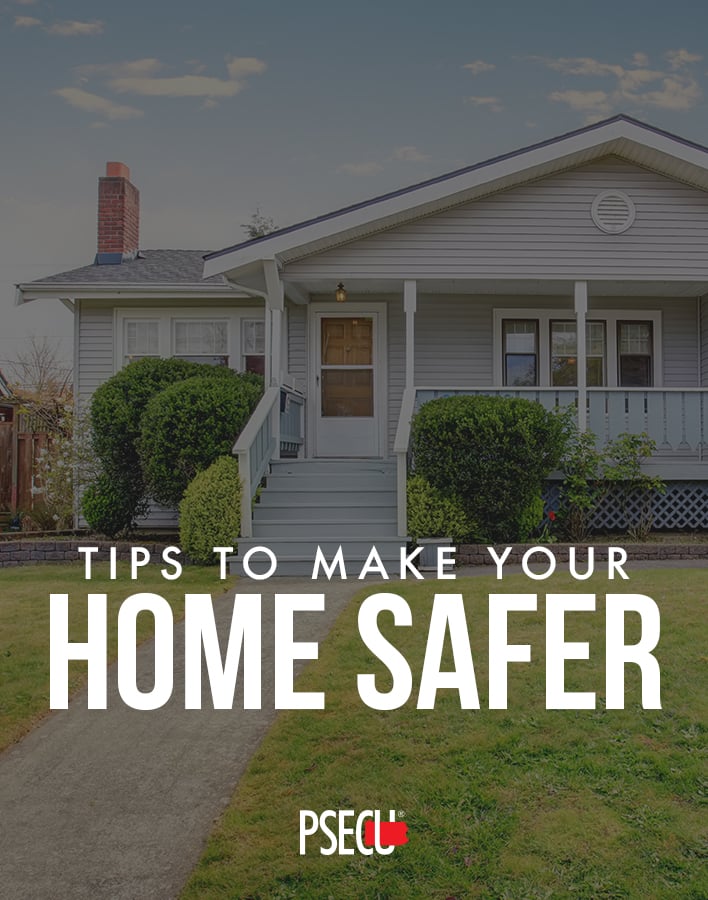 A burglary might involve items being taken from your home or property, or it might not. Although many people associate burglary with breaking and entering — whether by picking a lock, breaking a window, or causing other damage to an entryway — it can also include merely turning the doorknob and walking into your home.
A burglary might involve items being taken from your home or property, or it might not. Although many people associate burglary with breaking and entering — whether by picking a lock, breaking a window, or causing other damage to an entryway — it can also include merely turning the doorknob and walking into your home.
There is some good news when it comes to burglary. According to data from the Federal Bureau of Investigation (FBI), property crime, including burglary, has been decreasing for the past 14 years. In 2016, property crime fell by 1.6 percent compared to statistics from the year before.
There were just under eight million property crimes in 2016, and burglary accounted for around 19 percent of those crimes.
A Close Look at Injuries at Home
Having a stranger break into your home and take something isn’t the only thing you should be concerned about when it comes to making your home safer. Unintentional injury stemming from things such as fires or accidents is another thing to protect your home and family against.
While thefts and break-ins are decreasing, the number of deaths from unintentional injuries has increased, according to data from the National Safety Council. Nearly 170,000 people died as a result of unintentional injuries in 2017, a record high. While some accidental injuries occur outside of the home, such as those caused by car crashes or natural disasters, a considerable number of them do happen at home.
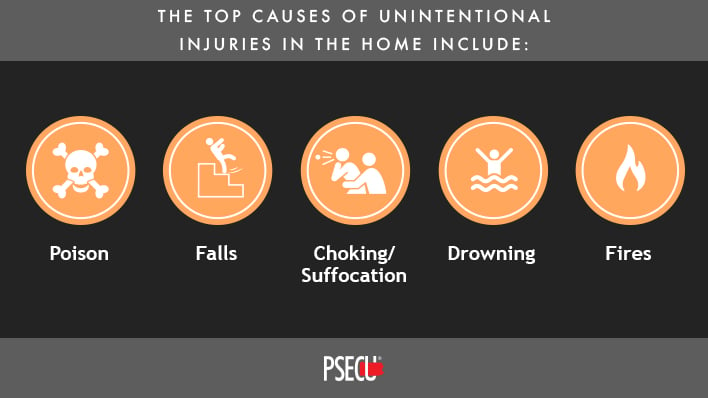
The top causes of unintentional injuries in the home include:
- Poison – People can be poisoned at home by several things, such as carbon monoxide, exposure to certain chemicals, and medications or drugs.
- Falls – Falls are the third leading cause of unintentional injury and death among people of all ages, but are the number one cause of injury and death for those over the age of 65.
- Choking/Suffocation – Choking or suffocation is likely to occur more in specific age groups — such as infants and those over the age of 87.
- Drowning – Drowning is the leading cause of unintentional injury/death in children between the ages of one and four.
- Fires – In 2015, more than 2,600 deaths occurred as a result of injuries or burns caused by a fire.
How to Make Your Home Safer: 6 Things to Do
Although it’s easy to look at the statistics and quickly feel panicked or alarmed, there are steps you can take to protect your home and make it a safer place to be. You can spend a lot of money when it comes to improving the safety and security of your home, but you don’t have to. There are a few budget-friendly options out there that will help protect your family. Here are six of them:
- Evaluate Your Locks
Not all locks are created equal. Some are very high-tech and designed to withstand a battering, while others are downright flimsy. If it’s been some time since you thought about the locks on the exterior doors of your home, it can be worth your while to either re-key or replace them.
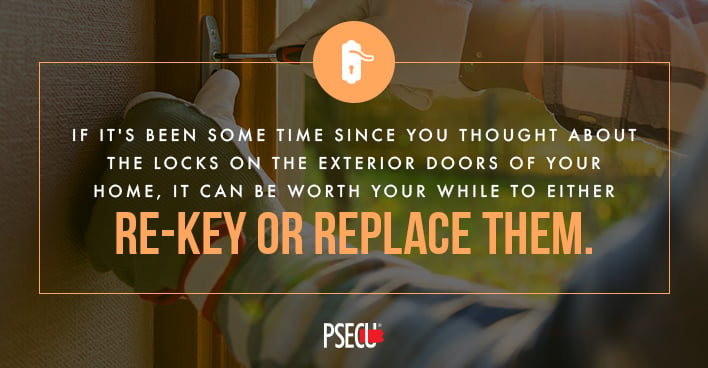
If you’re moving into a home or apartment for the first time, it’s a good idea to get new locks on the doors, even if the locks included are designed to be burglar-proof. You have no way of knowing who or how many people have a key to the house, or whether or not they plan on dropping in at any point in the future. If you’re moving into a rental home or apartment, you may not be permitted to change the locks yourself, but should check with your landlord to find out if locks are changed between residents and if you’re able to request new locks upon move in.
One thing that can be worth adding to any exterior door in your home is a deadbolt. Deadbolts offer more protection than a lock on a doorknob because the bolt stretches deeply into the door jamb. Better quality deadbolts are made of sturdy steel, which also makes them more difficult to break.
Getting in the habit of locking your doors at all times will help make your home safer.
- Upgrade Your Doors
Having the best lock can only do so much to keep your home safe. It doesn’t make sense to invest in the highest-quality, smartest locks, then put those locks on a flimsy, hollow-core wood door. If you’re going to upgrade your locks, it can also make sense to improve the exterior doors of your home.
If you have hollow-core wood doors, trade them in for either steel doors or solid wood. If you have windows on your front or back doors, you might want to switch to solid models. The windows might let more light into your home, but it’s also very easy for someone to shatter one of the panes, reach in, and unlock the door.
If you have sliding glass doors that lead out to a balcony or deck, one way to make them a bit more secure is to put a broomstick or other long handle between the door and the frame on the other side. The stick will make it more difficult for a thief to break in or force the door open.
- Keep Expensive Items Out of Sight
You wouldn’t put up a huge sign letting neighbors and strangers know all about the cool stuff you have in your home. But if you set up your 60-inch flat screen TV in front of your living room windows or regularly leave your laptops and tablets lying around, that’s exactly what you’re doing.
There are two ways to keep your valued possessions out of sight — and out of the minds of burglars. One technique is to keep the blinds or curtains on your windows closed so that people can’t peek in and scope out what you own.
The other way is to keep your valuables tucked away securely when you’re not home. Stash your expensive, fine jewelry in a safe that’s in an unusual or out-of-the-way area, for example. Burglars know to look in the more obvious locations for costly items, such as the nightstand, dresser, or medicine cabinet.
Whenever you get a new gadget or expensive item, be extra cautious about tossing its packaging out on the curb for recycling or trash pick-up. Leaving the box of a new flat screen TV or laptop out with the rest of your trash or recyclables is a pretty obvious way to advertise the fact that you recently bought something new and valuable. If you can, either cut up the packaging so it’s unrecognizable or take it to the recycling center yourself.
- Check Your Home Regularly
Houses get old, and things start to wear out. Keeping your home in good condition will help reduce the risk of particular vulnerabilities or weak spots. For example, you might want to check in on your windows every so often to make sure they still lock securely and that the panes aren’t loose in the frame.
When inspecting your home, it can help to think like a burglar. Take a look at windows and doors and consider ways that someone who wanted to get in might force his or her way inside. For example, if you have a window on the first floor open, you might consider keeping it shut and locked at all times. If you use window air conditioning units, properly secure and lock the window around the unit. If there’s a tree by your house, look to see if any of the larger branches are right below a window.
- Clean Up Your Landscaping
Shrubs and bushes by the windows and doors of your home can give thieves a place to duck away and hide while they try to jimmy a lock or open a window. It can be a good idea to replace heavy shrubbery with small trees or plants.
- Install Lights
The more well-lit your home is, the less likely an intruder will feel comfortable prowling around in the dead of night. Motion-activated lights on your home’s exterior can be particularly useful for deterring thieves, as they switch on whenever someone gets within a certain distance of your home.
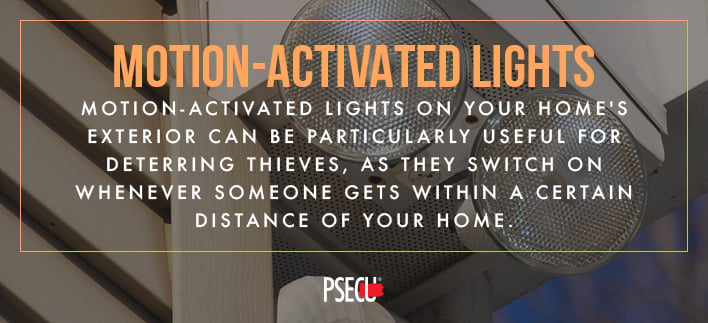
Having lights on inside the home can also keep thieves away. If you’re often away from home in the evenings or overnight, you might consider purchasing a timer or two. The timer will turn the lights on at a specific hour each night, then switch them off again in the daytime.
Should You Install an Alarm System?
Installing an alarm or security system can make your home safer, but alarm systems also tend to be expensive, depending on the level of service you purchase and the type of alarm you install. A security system can give you an extra layer of protection or help improve your peace of mind. Consider shopping around to determine what company will give you the system features you want for a price that fits your budget.
Need financial assistance to make your home safer? Check out our equity loan rates.
How to Protect Your Home When You’re Away
A home left empty and alone while your family is on vacation can be a particularly attractive target for thieves. Here’s what you can do to protect your home from a distance:
- Ask a neighbor to check in. It’s a good idea to ask someone, such as a neighbor or friend, to check in on your house daily or every other day while you’re away. Your friend can make it look like something is going on at home so that it’s not immediately obvious to anyone who passes by that you’re not around.
- Stop your mail, newspapers, and other deliveries. Even if you do have a friend or neighbor drop in regularly while you’re gone, it’s a good idea to contact the post office and ask them to hold your mail while you’re away. This way, bills or other documents with sensitive information aren’t piling up in your absence. It’s also a good idea to put any newspaper or other regular deliveries on hold while you’re gone so it’s not obvious to passersby that no one has been home for a while.
- Hire a landscaping service. If your front yard is usually neat and tidy, having it grow unruly when you travel for a week or two can send a clear signal to burglars that you’re not there. It can be worthwhile to hire a lawnmowing or landscaping company to drop in once or twice while you’re away.
- Put stuff away. Don’t leave anything out in the yard that would be appealing to a thief — such as grills or bicycles. Likewise, don’t leave anything out that would make it easier for someone to break in, such as a ladder.
- Use timers. Hook up a few lights in your home, as well as a TV, to timers and have them switch on and off throughout the day or night.
- Don’t leave keys out. Give a trusted friend or neighbor a copy of your house key, rather than leaving one under a doormat.
- Keep your vacation off social media. Even if you have your social media profiles’ privacy settings locked so that only your friends can see what you post, it’s still better to be safe than sorry. You can always share photos of your trip when you return.
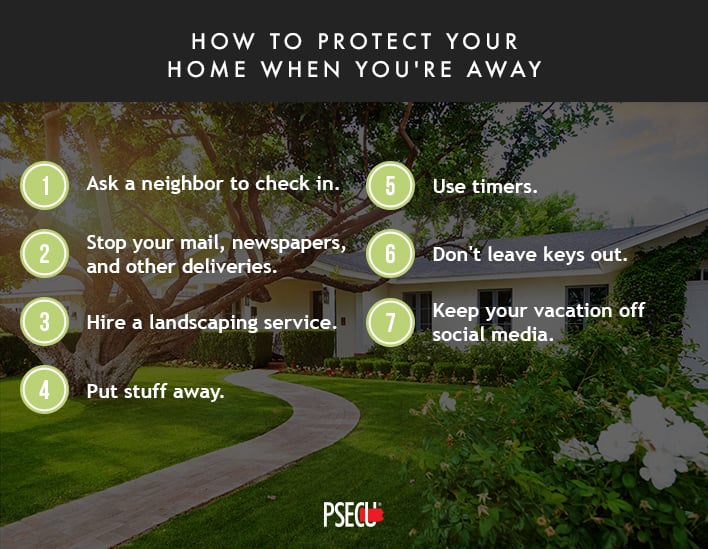
How to Keep Your Loved Ones Safe at Home
Along with keeping burglars out of your home, it’s also important to take steps to make your house safe for your kids and other family members. Following these home improvement safety tips can help you and your loved ones avoid the more common causes of accidental injury.
Install Smoke and Carbon Monoxide Alarms
The majority of deaths caused by home fires take place in homes that don’t have working smoke alarms or any smoke alarms at all. Smoke alarms aren’t costly and can do a lot to save your life and the lives of your loved ones.
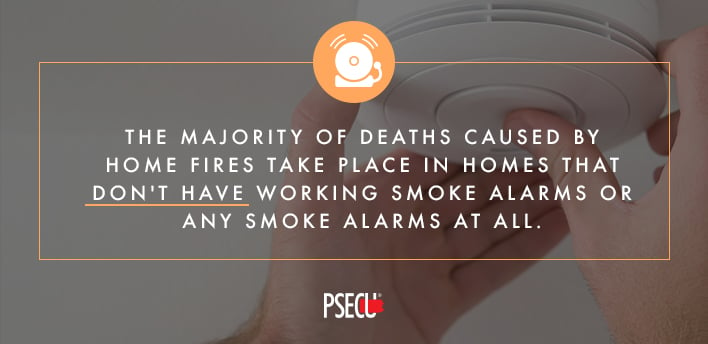
Installing working smoke alarms is just the first step. You also want to pay attention to where the alarms are installed and check on them regularly to make sure they work. For the alarms to be as effective and protective as possible, you need to make sure your home has one:
- On each floor
- In each bedroom or sleeping area
- Just outside of the bedroom or sleeping area
Although some people recommend replacing your smoke alarm’s batteries when you adjust the clocks forward or back for Daylight Saving Time, it’s actually a better idea to get in the habit of checking your alarms each month and replacing the batteries as needed. If you’re worried you’ll forget, program a reminder into your phone or calendar for the first of each month.
While you usually can smell smoke, carbon monoxide is odorless. It’s also clear and tasteless. Installing a carbon monoxide alarm in your home will alert you when there are high levels of the poisonous gas in the air. Like smoke alarms, you want to have at least one carbon monoxide alarm on each floor of your home and in the areas where your family sleeps.
Keep Dangerous Items Out of Reach
Items that don’t seem like such a big deal in the hands of responsible adults, such as a bottle of bleach, a kitchen knife, or a bottle of medicine, can be dangerous in the hands of a baby or child. Keep anything that could hurt a small child well out of reach and/or locked away.
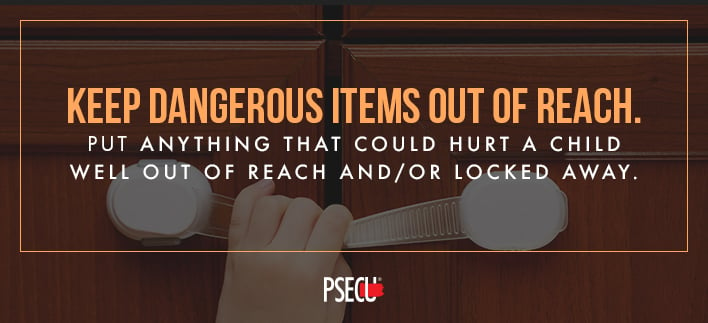
For example, keep your cleaning products on the top shelf of a cabinet or in a closet. To make sure the products are unreachable, install a baby- and kid-proof latch on the cabinet door or a chain lock on the closet door.
Don’t leave sharp knives out on the counter in a knife block or display them on a magnetic rack on the wall. Instead, tuck them away in a high drawer or cabinet — with a baby- or kid-proof latch.
Keep Your House Tidy
Whether you live with older parents or have young kids underfoot, keeping your house clean and the floors clear of clutter can help reduce the risk of falls. Have your kids get in the habit of cleaning up and putting away their toys after playing with them so there’s less chance someone will trip or slip.
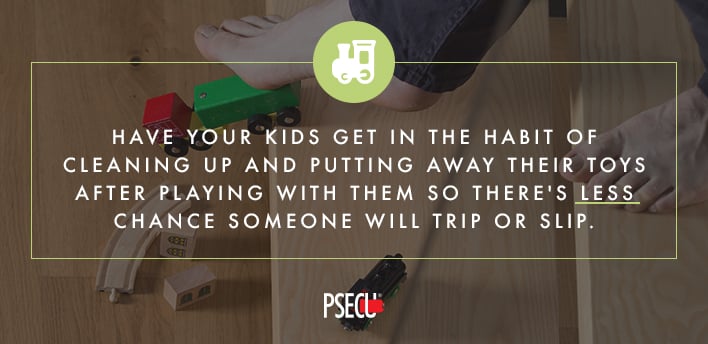
Along with making sure things are picked up off the ground, pay attention to anything else on the floor. For example, cords that stretch across the hallway or living room can be a tripping hazard. Instead, make sure any cords or cables are run along the wall and that plugged-in items remain as close to the outlet as possible.
Also, keep an eye out for torn carpeting or uneven floor rugs, which can be a tripping hazard.
Keep an Eye on Your Children
Young kids and babies, in particular, shouldn’t be left alone. Here are a few instances when you want to make sure you always have an eye on your children:
- When they’re in the bath, in the swimming pool, or near water.
- When they’re on a changing table or sitting in a high chair.
- When you’re cooking or working in the kitchen.
- When they’re outside.
- When they’re near stairs. When babies are learning to walk or crawl, putting gates at the top and bottom of the stairs can prevent tumbles.
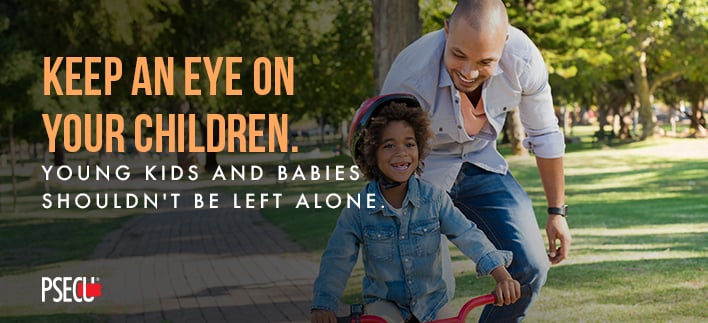
Your home should be your haven. With a few smart tricks and tips, it can be. Remember, keeping your home and family safe doesn’t have to break the bank or cost a lot. Staying two steps ahead of a burglar and being proactive about safety will help you enjoy a secure home for years to come.
Find more money management tips and resources on our WalletWorks page.
The content provided in this publication is for informational purposes only. Nothing stated is to be construed as financial or legal advice. Some products not offered by PSECU. PSECU does not endorse any third parties, including, but not limited to, referenced individuals, companies, organizations, products, blogs, or websites. PSECU does not warrant any advice provided by third parties. PSECU does not guarantee the accuracy or completeness of the information provided by third parties. PSECU recommends that you seek the advice of a qualified financial, tax, legal, or other professional if you have questions.
